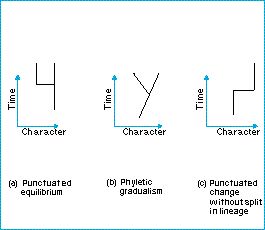Rates of evolution - What is punctuated equilibrium?

Punctuated equilibrium
Punctuated equilibrium is the theory put forward by Eldredge and Gould to explain the fact that the fossil record does not show smooth evolutionary transitions.
A common pattern is for a species to appear suddenly, to persist for a period, and then to go extinct. A related species may then arise, but with little sign of any intermediate forms between the ancestor and descendant.
According to the theory of punctuated equilibrium, evolution proceeds relatively rapidly during speciation: between speciation events the population remains relatively constant in a condition called stasis. Speciation occurs through the peripheral isolate model when a sub-population splits off and evolves rapidly into a new species.
It has also been suggested by Gould that punctuated equilibrium is due to macromutations.
Punctuated equilibrium versus phyletic gradualism
Punctuated equilibrium can be contrasted with evolution by phyletic gradualism, in which evolution occurs at a constant rate. Eldredge and Gould claim that this hardly ever happens and the dispute between the two theories is one of the most important in evolutionary biology.
Figure: the crucial difference between punctuated equilibrium and phyletic gradualism concerns the rate of evolution at, and between, splitting events. (a) punctuated equilibrium; (b) phyletic gradualism. On a strict interpretation of punctuated equilibrium, sudden change without splitting (c) contradicts the theory.
| Next |



